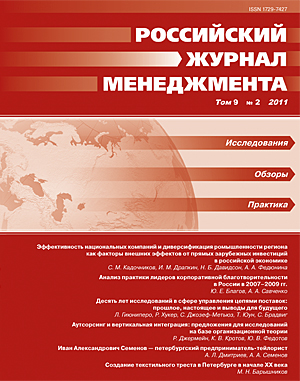Эффективность национальных компаний и диверсификация промышленности региона как факторы внешних эффектов от прямых зарубежных инвестиций в российской экономике
Аннотация
В статье представлена оценка внутри- и межотраслевого влияния прямых зарубежных инвестиций (ПЗИ) на деятельность российских компаний. При анализе базы данных по российским промышленным предприятиям за 1999–2008 гг. мы обнаруживаем наличие положительных внутри- и межотраслевых внешних эффектов от ПЗИ. Выделены два важных фактора, влияющие на знак и величину внешних эффектов от ПЗИ, — уровень эффективности национальных компаний и степень диверсификации промышленности региона. Мы пришли к выводу, что более эффективные российские компании испытывают меньшее конкурентное давление со стороны иностранцев по сравнению с менее эффективными фирмами. В то же время менее эффективные российские производители получают бóльшие выгоды от взаимодействия с иностранными компаниями в вертикально взаимосвязанных секторах экономики в сравнении с более эффективными компаниями. В российских регионах с относительно диверсифицированной структурой промышленности обнаружены положительные внутриотраслевые эффекты от иностранных инвестиций, в то время как в узкоспециализированных регионах знак этих эффектов меняется на отрицательный, но остается все же положительным в случае межотраслевых вертикальных эффектов.
Ключевые слова:
прямые зарубежные инвестиции, внешние эффекты, вертикально взаимосвязанные отрасли, диверсификация, пространственное развитие
Скачивания
Библиографические ссылки
The List of References in Cyrillic Transliterated into Latin Alphabet
Загрузки
Опубликован
Как цитировать
Выпуск
Раздел
Лицензия
Статьи журнала «Российский журнал менеджмента» находятся в открытом доступе и распространяются в соответствии с условиями Лицензионного Договора с Санкт-Петербургским государственным университетом, который бесплатно предоставляет авторам неограниченное распространение и самостоятельное архивирование.





